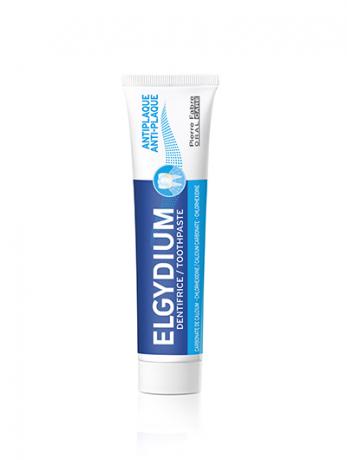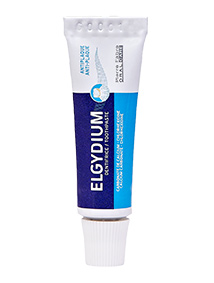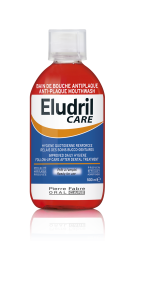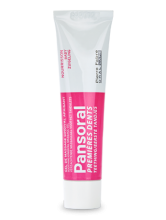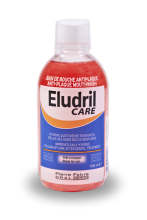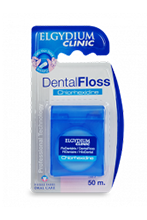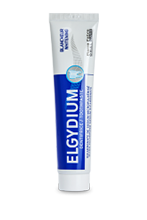Fighting dental plaque
What is dental plaque?
Dental plaque, a thin film of bacteria
Dental plaque is a whitish or yellowish film that forms on the surface of the tooth, particularly where the tooth meets the gum. It is made up of salivary proteins, food residue and bacteria.
Although dental plaque is not very adhesive when it first forms, it tends to quickly harden and stick to the surface of the teeth, making it more difficult to remove by brushing. If left, it will mineralise and form tartar deposits.
Bacteria found in the mouth
It is estimated that the mouth is home to around 25,000 different types of bacteria, one thousand of which are found on the teeth alone. Among this flora are many bacteria that help keep our mouth healthy. However, it also contains bacteria that, when they flourish, are responsible for the three main tooth and gum diseases: gingivitis, periodontitis and tooth decay. In all cases, it is the build-up of dental plaque that marks the start-point in the development of these diseases.
Formation of dental plaque
As soon as you stop brushing, a film of salivary proteins forms on the teeth (the dental pellicle). Certain bacteria in the mouth (Streptococci and Actinomyces) adhere to this film and proliferate. Other bacteria then join and together they produce an organic matter that protects them. This all forms the thin film on the teeth that we call dental plaque
What is the difference between new dental plaque, old plaque and tartar?
During the first two days of its formation, dental plaque is not very solid and cannot withstand brushing: this is new plaque. However, after 48 hours it becomes tougher: this is then called old plaque, which tends to stick stubbornly to the surface of the teeth.
If the teeth are not brushed, this old dental plaque will gradually mineralise, incorporating calcium phosphate salts from the saliva and it becomes tartar.
Toothpaste is less effective on old plaque, and completely ineffective against tartar deposits. These can only be removed by the dentist
Dental plaque, the enemy of oral health
The complications of dental plaque
When dental plaque is left, it solidifies and forms an environment in which various bacteria can flourish, protected from the toothbrush. These deposits are most often at the base of the teeth (where they enter the gum), in areas on which the tongue and cheeks do not rub on the tooth surface, in the spaces between the teeth, and around dental prosthetics or braces.
The bacteria that proliferate in the dental plaque secrete acids which erode the enamel and attack the dentine, triggering tooth decay.
They also cause gum inflammation, known as gingivitis. Unless treated, chronic gingivitis will eventually develop into periodontitis, an infection that destroys the tissues that attach the tooth to the gum, and even the bone of the jaw.
Gingivitis: a warning sign
In the case of acute gingivitis, the gums become red, swollen and sensitive, to the point that chewing becomes uncomfortable. They bleed easily. In more serious cases, there can be discharges of pus accompanied by bad breath. If treated, gingivitis is reversible.
Gingivitis should be heeded as a sign that warns of the presence of dental plaque or tartar and is a very good reason to consult your dentist.
Periodontitis: a serious and irreversible disease
The tissues that support the teeth are known as the periodontium. Gingivitis can often lead to the inflammation of these tissues, which is what we then call ?periodontitis?. Periodontitis is sometimes accompanied by a discharge of pus and bad breath. When the periodontium degenerates, periodontitis causes teeth to become loose and they can fall out.
Periodontitis is a serious condition as it causes irreversible damage.
The risk factors for dental plaque
Poor oral hygiene
The main cause of stubborn deposits of dental plaque and tartar is an inadequate hygiene routine for the mouth and teeth. Brushing your teeth twice a day, using dental floss or interdental brushes, and supplementing these actions with a cleansing mouthwash, are all beneficial preventive measures.
Dental plaque forms more readily with age
The older you become, the less saliva you produce leaving you more exposed to a build-up of dental plaque. The elderly are therefore more sensitive to sugary food and may also experience problems brushing their teeth, due to osteoarthritis for example.
In addition, many also have to take medication with side effects that can inhibit saliva production, making dental plaque deposits worse.
Personal predisposition to dental plaque
Certain people are more susceptible to the problem of dental plaque and tartar because of the nature of their mouth's bacterial flora, the pH of their saliva or the position of their teeth.
Prosthetics, braces and dental plaque
Prosthetics and braces complicate brushing and create nooks and crannies that are difficult to clean. People who wear them must pay very close attention to oral hygiene to avoid suffering from a build-up of dental plaque.
Lifestyle and dental plaque
Smoking and excessive consumption of alcoholic drinks may exacerbate dental plaque and tartar formation because they can dry out the mouth and upset the delicate balance of bacterial flora.
How can dental plaque be prevented from building up?
1. Meticulous brushing and good interdental hygiene
Brushing your teeth (twice a day) is still the best way to prevent a build-up of dental plaque. The spaces between the teeth should also be cleaned with dental floss or interdental brushes (once a day). In addition, a cleansing mouthwash will reach areas where the toothbrush, floss and interdental brush could not
2. Choose an effective toothbrush and check how well you have brushed your teeth
Some toothbrushes have crossed bristles (laid out in different directions), which brush in a number of different directions all at once. The ELGYDIUM Anti-plaque toothbrush is therefore particularly well designed for eliminating dental plaque in the areas that are hardest to reach.
Plaque-disclosing dyes can be used to check how effective your brushing method is. Your dentist or pharmacist can advise you.
3. Dental floss, interdental brushes and mouthwash
To eliminate dental plaque in the spaces between the teeth, you can use interdental brushes, dental floss, like Elgydium Clinic Dental Floss Chlorhexidine, followed by a mouthwash to complete the oral hygiene process in areas that are impossible to reach with brushing or flossing methods.
4. A toothpaste to strengthen the enamel
A toothpaste enriched with fluoride, for example ELGYDIUM Anti-Plaque toothpaste, leaves the enamel and dentine more resistant to acidic substances, and helps limit the bacterial activity in dental plaque.
Dentists may prescribe medicated toothpastes for some of their patients.
5. Regular visits to the dentist
Old plaque is more difficult to remove by brushing and only the dentist can remove tartar, so it is essential to consult your dentist at least twice a year, or at the first sign of gingivitis.
Dental Plaque
Dental plaque is oral health’s enemy number one. Arm yourself against the bacteria that cause it by choosing the right weapons!
See the program